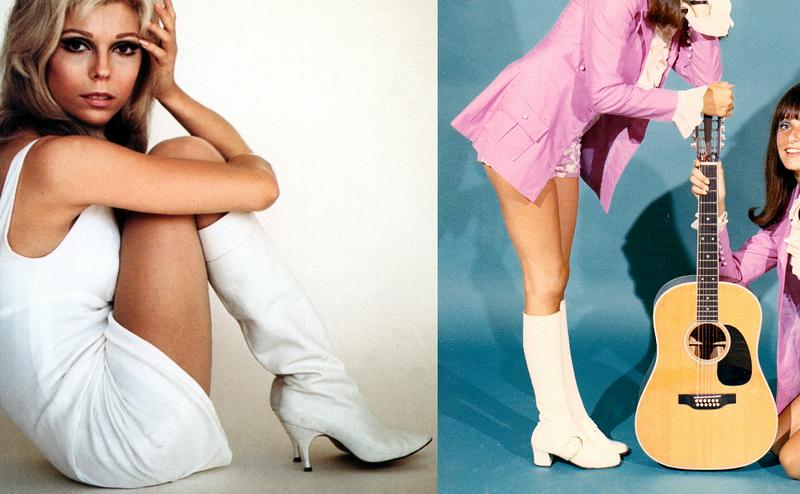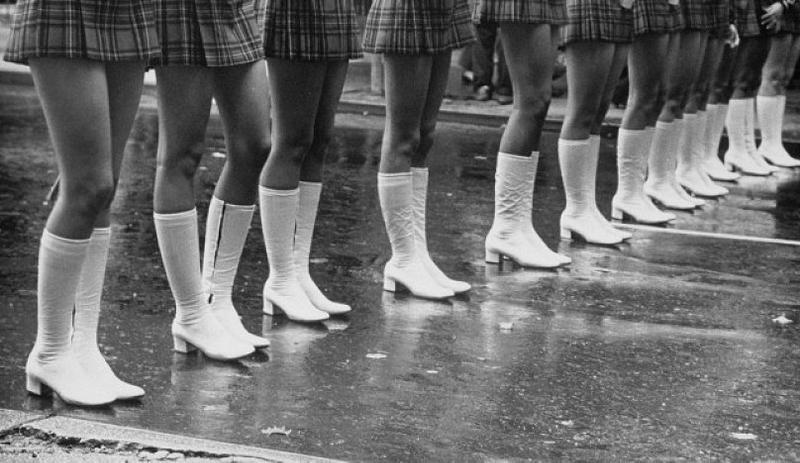Go-Go Boots: A History Of The Footwear That Ruled The 1960s
By | February 12, 2019

Go-go boots were mod; they were space-age; they appealed to hippies and Motown divas and high-street fashionistas alike. They were a little bit cutesy and a little bit rock 'n roll. Thanks to Nancy Sinatra and plenty of stylish female celebrities of the 1960s and '70s we're all familiar with this calf-high footwear, but the history of go-go boots is less well-known. In fact, go-go boots, along with miniskirts and flip hairdos encapsulate the fashion sense of an era -- and still take us back to the days of a somehow more innocent sex appeal. Patent leather or shiny vinyl, usually white -- there's no denying they have a sanitized fetish element, what we used to call "kinky."
But go-go boots were also empowering -- they were the boots of science fiction sirens, stylish female spies and Bond girls. Go-go boots looked good on everyone -- from hip professionals to cheerleaders to flight attendants. From Indigenous folk singer Buffy Sainte-Marie to blaxploitation vixen Pam Grier. The 1960s and '70s were a tumultuous, glorious time in pop culture and history. And go-go boots were there, every step of the way
Boots went From Utilitarian to High Fashion

Prior to the 1960s, boots were hardly viewed as a fashion accessory. They were merely work boots with a utilitarian purpose. But the 1960s saw an increase in haute couture, influential fashion designers, and outside the box thinking. From bold designs, short hemlines, and asymmetrical lines, the new styles were unlike any previous decade.
Go-Go Boots Are Credited To A French Designer And His 'Moon Girl' Look

In 1964, French fashion designer Andre Courreges introduced a thoroughly modern and futuristic collection he called his “Moon Girl” look. The collection featured A-line skirts and dresses, monochromatic color palettes and clinical white schemes, drop-waisted mini skirts, and tall, white, flat-heeled boots -- the first go-go boots.
Other Designers Included High Boots In Their Collections

The tall, white boots were so well-received that other designers began to include them in their fashion collections. Soon the boots were walking the runways in Paris, New York, and London. It was the Brits who first embraced the boots in street fashion. In the '60s, the Mod subculture of London was influencing the mainstream fashion world. Bold, block designs, creative uniformity, and the use of lines and shapes were all hallmarks of the Mod style and Londoners set the standard for the look. Go-go boots were included in this ultra-hip, ultra-modern fashion statement.
Go-Go Boots And Mary Quant

Although British designer Mary Quant did not come up with go-go boots herself, they certainly enhanced the fashion firsts she did develop. Quant is the fashion designer who created the mini skirt and the hotpants, two defining styles of the Mod era. As the skirts and pants got shorter and shorter, the accompanying boots got taller. Perhaps it was a way for the wearer to enjoy a short, scandalous miniskirt without showing too much skin. Or it was, as Quant believed, a way to highlight and accentuate the shapely leg.
Go-Go Boots Jumped The Pond

The Beatles helped to usher in the British Invasion in the United States and teens and young adults clamored for all things English. The Mod designs, that were once distinctly British, jumped the pond and took root in the U.S. As the sixties progressed, the go-go boot became standard wear for every teenage girl in the country.
How Go-Go Boots Got Their Name

Television dance shows, such as Hollywood A Go-Go, The Music Scene, and Where The Action Is, were wildly popular and influential in the groovy era. Teens watched these shows for the live music, dancing, and fashion. The dancers on these shows discovered that the low, block heel of the go-go boots was more comfortable than the platform shoes and spike-heeled shoes. They could dance longer in go-go boots without their feet hurting. Some fashion historians state that the go-go boot took its name from the go-go dancers on the Hollywood A Go-Go show, which itself borrows the French phrase a go-go, meaning "abundant." But others assert that the term go-go came from the French word, la gogue, which means “joy and happiness.”
Go-Go Boots Leave Haute Couture Behind To Appease The Masses

As go-go boots became more popular and mainstream, footwear companies responded to the demand by offering inexpensive go-go boots made with cheaper materials. While the high-end go-go boots may have been made from patent leather, the less costly go-go boots were made from vinyl. The boots were made to hug the calf to create a sleek silhouette. Some had zippers up the back and others had them on the side.
Nancy Sinatra Helped Boost The Popularity Of Go-Go Boots

In 1966, Nancy Sinatra released her number one song “These Boots Are Made for Walkin’,” which naturally drew attention to the stylish go-go boots. The song captured the zeitgeist of the sixties and became a female empowerment anthem, that also helped to increase the popularity of the go-go boots.
